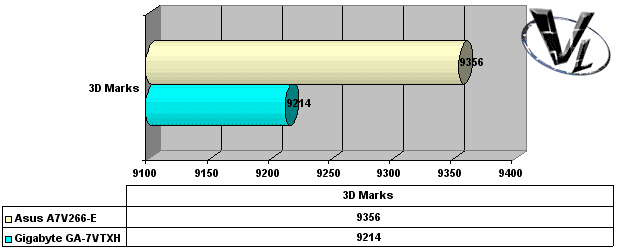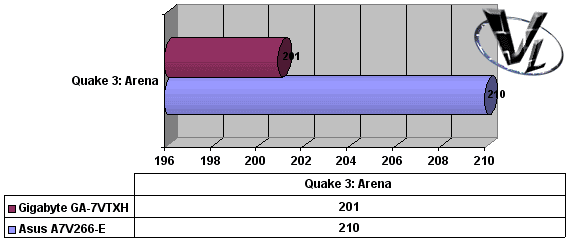3D Mark 2001SE
Another new release by , we'll be replacing the old 3D Mark 2001 in favor of this one. There are some bug fixes, and better Direct X 8 support, depending on what video card you have. Here's their blurb...
3DMark®2001 Second Edition, is the latest installment in the 3DMark® series. By combining DirectX®8.1 support with completely new graphics, 3DMark2001 SE continues to provide benchmark results that empower you to make informed hardware assessments.

We used a resolution of 640x480, and 16Bit colour. FSAA was off, and decided that these setting will allow the benchmark to tax the main subsystem as much as possible. I was actually quite surprised to see the A7V266-E come out on top by over 100 3D Marks.
Quake 3: Arena
Although it's getting long in tooth, the Quake 3 engine is still a useful tool in gauging overall system performance. Like our 3D Mark benchmark, 640x480 resolution was used, and set to the "Fastest" setting. We used the v1.31 point release, and the timedemo was demo four.

Here we see the Asus soundly beat the Gigabyte. We ran the benchmark several times, of course, and noticed a minimum of 8 frames per second difference consistently with the A7V266-E.
Final Words
I come away from this review quite happy with the performance and stability of the A7V266-E, but there are a few details that bother me.
To begin with, the addition of the ACR slot is a waste of PCB space. I am aware it's there for OEM purposes, but it's still not needed in my opinion. I know it's better than adding another ISA, but I'm sure some people would prefer a 6th PCI slot. BIOS adjustments are there, but some important features, such as manipulating the PCI divider, are missing altogether. Another nag I have is the boot time of the motherboard. Due to the fact that the Promise controller cannot be disabled, on our XP 2000+ setup, the wait until the Windows XP logo startup is a good 10 seconds. Finally, the last problem we've had was that with any system error, be it extreme overclocking gone wrong, or an improper power down, our BIOS always seems to reset itself to defaults. This is a handy precautionary measure, but it's a pain in the ass to reset everything.
This has been brought up, and I've said it in the past, but it deserves a reminder. I should point out that our CPU was locked because I have neither the tools or proper skill set to unlock it. To be honest, I am not a huge believer in overclocking, nor have I ever claimed to be. Certainly, a large number of our readers are, and this will be something I'll look more into in the near future. Keeping that in mind, our FSB overclock is certainly far from being the highest attainable.
That being said, it has been fairly stable, despite the abuse we do to it. To be honest, we have not suffered a system crash, unless I did something purposefully to crash it. It is extremely fast, as are all KT266As, and being rock solid is an added bonus.
It is a bit expensive, when compared to the competition, but you do get the RAID and decent onboard sound, and it's still cheaper than Abit's solution. You have extra USB capability, and great overclocking potential.
With the KT333 out now, and with Asus releasing their KT333 solution, you may be wondering if this is worth the purchase. I say yes, as benchmarks show that the KT333 is only a slight improvement on the KT266A performance wise, and with its release, the KT266A will likely be fairly cheap. Also, as history shows, you're best to wait for VIA to release the next chipset; i.e., the "A" version.
Pros: Extremely fast, extra USB ports, solid construction, stable, CPU Overheat Protection.
Cons: Odd placement of floppy connections, long boot times, BIOS resets occasionally.
Agree? Disagree? Discuss it in our forums.
Previous Page - The BIOS and Overclocking
Home
